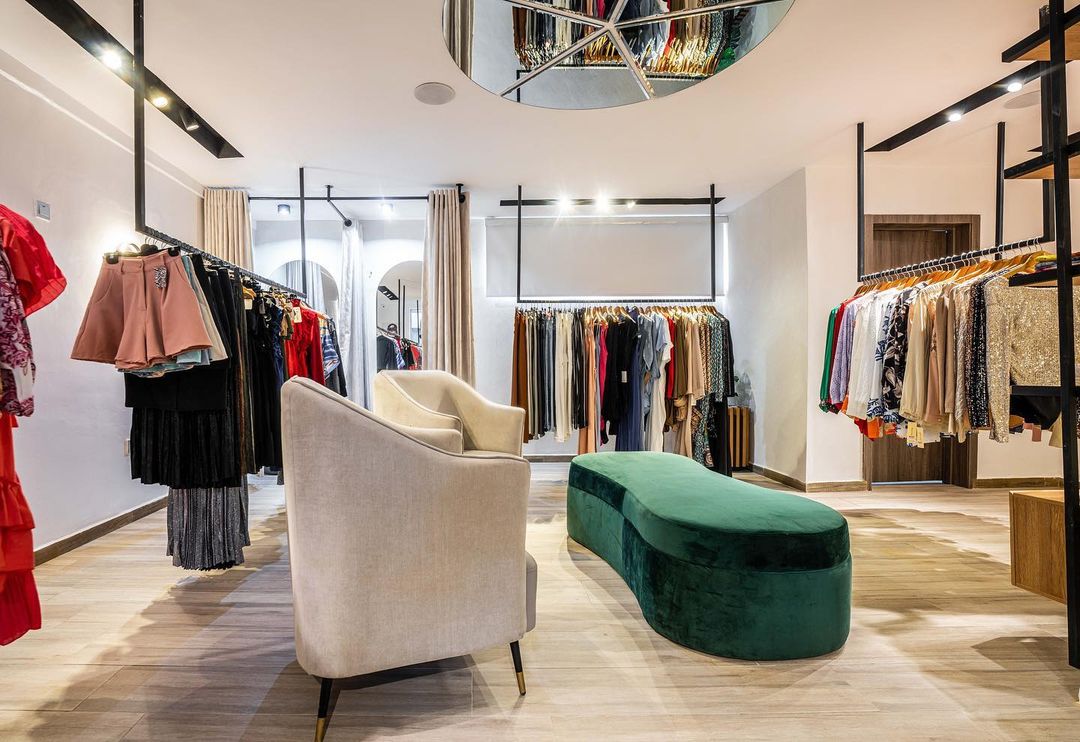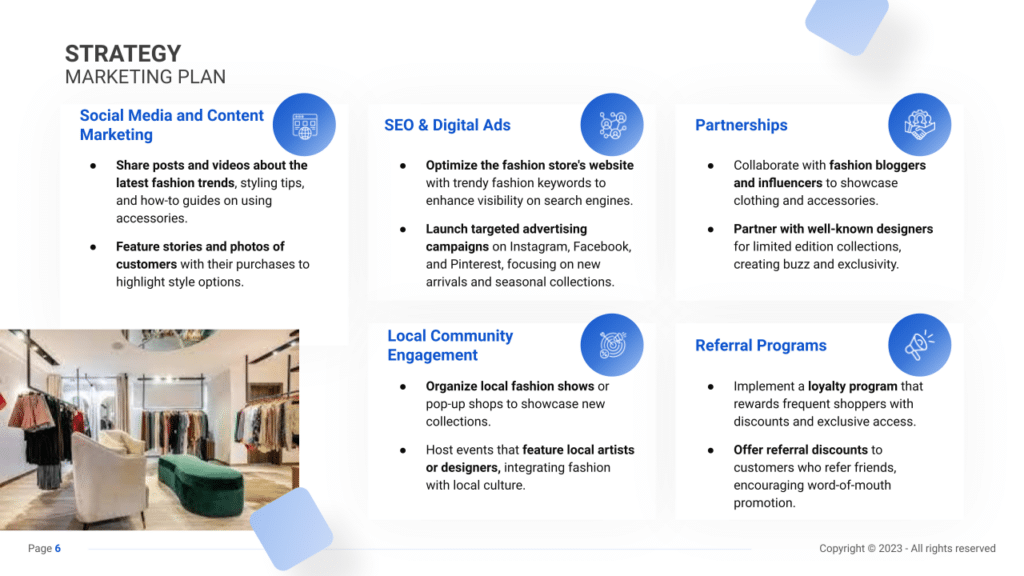Sales & Marketing Plan for a Fashion Store

Running a successful fashion store demands more than an eye for trends; it requires a strategic approach to marketing and sales.
This guide helps you craft a sales and marketing plan specifically tailored to the business plan of your fashion store.
Beginning with the importance of market analysis, we’ll delve into understanding competitors and discerning customer needs.
Following that, we’ll focus on establishing a distinctive brand identity and strategic positioning within the market.
Lastly, we’ll explore diverse marketing channels tailored to the fashion industry and examine effective sales strategies to boost revenue.

Market Analysis
Understanding the dynamics of the market is crucial for devising an effective sales and marketing strategy.
Competitive Analysis
- Identify Competitors: Research other fashion boutiques or stores in your area. Analyze their clothing collections, pricing strategies, customer reviews, and marketing approaches.
- SWOT Analysis: Evaluate your store’s Strengths, Weaknesses, Opportunities, and Threats concerning competitors. Identify areas where you can stand out and differentiate yourself.
Target Audience Profiling
- Demographics and Psychographics: Define the characteristics of your ideal customers: age, gender, income level, fashion preferences, and lifestyle choices. This information guides your marketing strategies and product offerings.
- Customer Preferences: Understand what your target audience seeks in a fashion store—whether it’s trendy apparel, sustainable fashion, high-end luxury items, or budget-friendly options.
Branding and Positioning
Crafting a compelling brand story and establishing a unique positioning strategy is crucial for standing out in a competitive fashion market.
Brand Identity Development
Your brand identity extends beyond a logo; it encompasses the essence and values of your fashion store.
- Brand Narrative: Develop a captivating brand narrative that shares your journey, inspiration, and commitment to delivering quality fashion products. Emphasize your unique selling proposition and how it addresses your customers’ needs.
- Visual Elements: Invest in a cohesive visual identity—create a captivating logo, define brand colors, and establish a consistent visual language across all touchpoints, including store design, packaging, and marketing materials.
Market Positioning Strategy
Determine how you want your fashion store to be perceived in the minds of your customers.
- Defining Your USP: Identify what sets your store apart. Whether it’s offering exclusive designer collections, sustainable fashion choices, personalized styling services, or a blend of affordability and style, a clear USP forms the foundation of your positioning strategy.
- Positioning Statement Refinement: Further refine your positioning statement to encapsulate the essence of your brand in a concise yet impactful manner. This statement serves as a guiding principle for all your marketing endeavors.
Marketing Channels
Explore various marketing channels to effectively reach and engage with your target audience.
Digital Marketing
In today’s digital age, leveraging online platforms is essential for brand visibility and engagement.
- Social Media Strategy: Develop a comprehensive social media strategy encompassing platforms like Instagram, Facebook, TikTok, and Pinterest. Utilize Instagram for visually appealing posts showcasing your latest collections, behind-the-scenes glimpses, and influencer collaborations. Use Facebook for community engagement, events, and targeted advertisements. Employ TikTok for short, engaging video content, and Pinterest for curated boards featuring fashion inspirations and trends.
- Email Marketing Campaigns: Build and nurture an email subscriber list by offering incentives like exclusive discounts or style guides. Create engaging newsletters featuring new arrivals, fashion tips, customer testimonials, and promotions to drive traffic to your store.
- E-Commerce Website Optimization: Develop a user-friendly website that showcases your collections, provides a seamless shopping experience, and integrates secure payment gateways. Optimize your website for search engines (SEO) to increase organic traffic and ensure visibility in search results.
Local Advertising
While digital marketing is crucial, local advertising helps target the immediate community.
- Print Media Campaigns: Place advertisements in local fashion magazines, newspapers, or lifestyle publications to capture the attention of local consumers. Highlight special promotions, events, or exclusive offers.
- Community Engagement: Organize fashion-related events, workshops, or collaborations with local influencers, designers, or stylists to create buzz and build a strong community presence.
Promotional Activities
Implementing well-planned promotional activities can attract customers and drive sales.
- Seasonal Sales and Campaigns: Plan and execute seasonal campaigns aligned with fashion trends and occasions. Launch promotions like ‘Back-to-School Fashion,’ ‘Holiday Glam,’ or ‘Spring Wardrobe Refresh’ to entice customers.
- Customer Loyalty Programs: Create a loyalty program that rewards customers based on their purchases or engagement. Offer exclusive perks such as early access to sales, birthday discounts, or VIP events.
- Referral Programs: Encourage existing customers to refer friends by offering incentives such as discounts, store credits, or exclusive gifts for successful referrals.

Sales Channels
Deploy effective sales strategies to maximize revenue and enhance customer satisfaction.
In-Store Sales Strategies
- Upselling and Cross-selling Techniques: Train staff to recommend complementary items or accessories to enhance the customer’s purchase. Encourage upselling by showcasing matching items or suggesting additional pieces during checkout.
- Visual Merchandising: Strategically design store layouts and displays to create an inviting ambiance and highlight featured collections or best-selling items.
- In-Store Events and Experiences: Organize exclusive shopping events, fashion shows, styling sessions, or trunk shows to provide customers with unique experiences and drive foot traffic to your store.
Online Sales Tactics
- Personalized Shopping Experience: Implement AI-driven recommendation systems on your website based on customer preferences, browsing history, or past purchases. Create a seamless navigation experience with filters and sorting options for easy product discovery.
- Virtual Shopping Tools: Offer live chat support for real-time assistance and consultation. Incorporate virtual try-on features or AR (Augmented Reality) technology to allow customers to visualize how the clothing will look on them.
- Mobile Optimization: Ensure your website is mobile-responsive, providing customers with a smooth browsing and checkout experience on smartphones and tablets.
Membership and Retention Programs
Encourage repeat purchases and customer loyalty through tailored membership programs.
- Exclusive Memberships: Develop tiered membership programs offering various benefits, such as tier-based discounts, early access to collections, free shipping, or dedicated styling services.
- Retargeting Strategies: Implement retargeting campaigns for visitors who have shown interest in specific products but haven’t made a purchase. Utilize personalized ads to re-engage them and encourage conversions.





